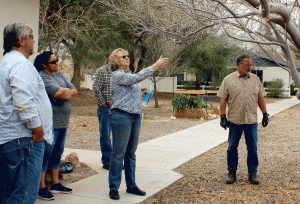By MAGGIE MCMURRAY
Moapa Valley Progress

The University of Nevada Cooperative Extension offered a workshop last week on one of its most requested subjects: pruning. Every classroom seat was full as UNCE specialist Dr. Angela O’Callaghan pf Las Vegas taught proper techniques that help to improve the look, health, and functionality of most trees and bushes grown in this area.
O’Callaghan used the first hour of the class to give a slide presentation covering the basics of pruning. The second hour was devoted to hands-on practice in the UNCE demonstration gardens.
O’Callaghan stressed that pruning is not the same as chopping. It is the careful removal of plant tissue that is keeping the tree from being its healthiest. She taught that the most foliage of any plant that can safely be removed at one time is 10 % for light pruning, which can be done usually at any time of the year; or 25% for heavy pruning that should only be done when trees are dormant. Removing too much foliage or removing it at the wrong time can leave the tree without the resources to keep itself alive.
How and where branches are cut from the tree can also greatly impact successful growth and tree health. O’Callaghan showed how to locate the bark ridge on a branch and how to cut a branch diagonally above the natural collar at this point.
The collar on a branch is a naturally swollen area at the base of each branch. When cut in this manner, the tree heals and protects itself in a manner far superior to any artificial sealant, barring the way against future pests and disease.
O’Callaghan also stressed the importance of doing an undercut first so that the weight of a branch doesn’t rip it from the tree as it is being cut.
Class attendees learned that is important to do a little research to know your plant. Some plants flower only on new growth produced that year. Trimming new growth on this type of plant will prohibit any flowering or fruiting. Some plants, however, produce on old wood produced the year before and trimming out old wood on these plants would have similar negative effects.
After going over the basics of pruning, O’Callaghan took her class outside for some practical experience.
They started on a relatively easy and straightforward Palo Verde tree. O’Callaghan pointed out undesirable plant tissue such a watersprouts, dead branches, and branches that may be detrimental to the tree now or in the future. Class members practiced identifying the branch bark ridge and the collar on each branch to know the proper place to cut.
The group then moved on to a Shoestring Acacia, an Arizona Rosewood, several types of shrubs and bushes, and a Desert Willow. At each stop, class members were invited to examine the tree, make comments or suggestions based on what they had learned, and then practice making proper cuts.
Class members were overwhelmingly positive about what they learned.
“This class was absolutely worth coming to,” said Maureen Gass of Logandale. “I’ve never taken a pruning class before and I learned a lot. I loved the hands on portion.”
“I’ve not only learned some of the things I’ve been doing wrong when I prune, but I learned how to do them correctly now,” said Jim Rimpau. “If I’d have taken this class years ago, I would have saved myself a lot of mistakes.”
O’Callaghan was happy she could come to Logandale and share her knowledge. “I am happy that I can share my education and my experience with people to help them achieve their gardening goals,” she said.
Local UNCE employee Dianna Walker helped organize the class. “I was so glad Angela could come because she is such an expert in this field and we get questions about pruning all the time,” Walker said. “This really helped answer a lot of these questions.”
O’Callaghan has authored a publication called Becoming a Desert Gardener that is a major source of information on how and when to plant things in this area. It is available free of charge at the Moapa Valley UNCE office and can be picked up during regular business hours.
The next free horticulture class offered by the local office will be a rose care class offered on February 24. For more information about the class, call the extension office at 702-397-2604.










